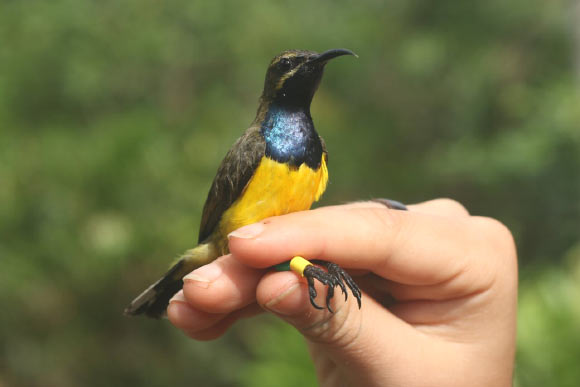Ornithologists from Trinity College Dublin and the Universitas Halu Oleo have identified several cryptic species in two sunbird genera, Cinnyris and Leptocoma.
The sunbirds (Nectariniidae) are a family of small passerine birds with a distribution extending from Africa in the west to Australia in the east.
These birds look similar to the American hummingbirds and fill a similar ecological niche.
Male sunbirds often have bright plumage, with iridescent feathers that shine in the sunlight.
Sunbirds have been admired by naturalists for centuries, and by artists for even longer: olive-backed sunbirds are depicted in reliefs on Java’s Borobudur Temple, dating to the 8th or 9th century CE, their search for nectar representing the Buddhist quest for enlightenment.
However, improved sampling and modern integrative methods are only now revealing the true diversity within these species.
In the new research, Trinity College Dublin researcher Fionn Ó Marcaigh and colleagues identified a new species in the genus Cinnyris.
Named Cinnyris infrenatus (common name is the Wakatobi sunbird), the bird lives on the Wakatobi Islands, an archipelago of deep-sea islands off south-east Sulawesi, Indonesia.
The researchers also examined the more widespread olive-backed sunbirds (Cinnyris jugularis) and black sunbirds (Leptocoma aspasia), and found that individuals named as such actually belonged to multiple unrecognized species.
“One of the British naturalist Alfred Russel Wallace’s major findings is referred to as ‘Wallace’s Line’ — a boundary between deep and shallow seas that many animals have been unable to cross, leading to marked differences in the species found on either side,” Ó Marcaigh said.
“The widespread olive-backed sunbird appeared to be an exception, being found all the way from China to Australia with Wallace’s Line right in the middle of its range.”
“Our study, however, has shown that the populations on either side actually represent two different species, in keeping with Wallace’s original predictions.”
“The black sunbird was already known to be subject to Wallace’s Line, but the research has shown that the population around Sulawesi is a separate species from the one in New Guinea.”
“Despite this split, the olive-backed sunbird covers quite a wide range for such a small bird.”
As well as being genetically unique, the Wakatobi sunbird also has darker plumage, a higher-pitched song, and shorter wings than the olive-backed sunbird.
Its short wings probably contributed to its remaining isolated on the Wakatobi Islands while the olive-backed sunbird was undertaking long-distance colonization over the sea.
“It’s amazing that there are still species waiting to be found in this region, which has been important to evolutionary biology since the time of Wallace,” Ó Marcaigh said.
“The identification of the Wakatobi sunbird serves to remind us that biodiversity is everywhere,” said Trinity College Dublin’s Dr. David Kelly.
“This bird wasn’t found in a remote rainforest, but along the scrubby margins of busy towns and villages.”
The discovery is described in a paper in the Zoological Journal of the Linnean Society.
_____
Fionn Ó Marcaigh et al. Small islands and large biogeographic barriers have driven contrasting speciation patterns in Indo-Pacific sunbirds (Aves: Nectariniidae). Zoological Journal of the Linnean Society, published online October 25, 2022; doi: 10.1093/zoolinnean/zlac081










